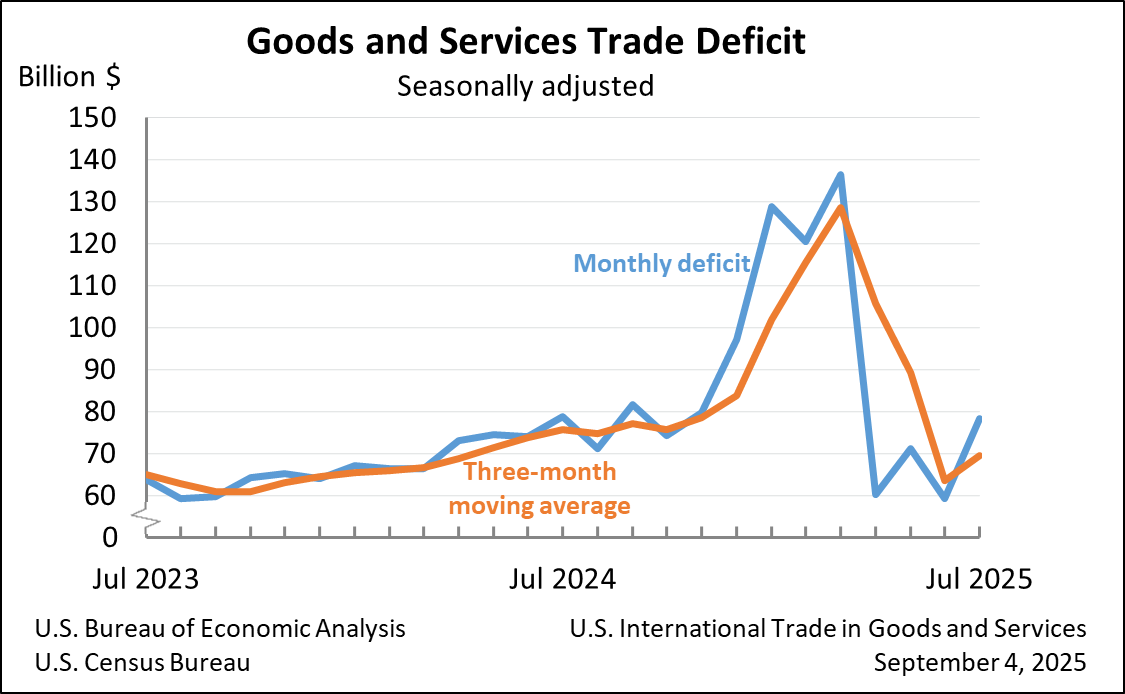Bureau of Economic Analysis
U.S. International Trade in Goods and Services, July 2025
The U.S. goods and services trade deficit increased in July 2025 according to the U.S. Bureau of Economic Analysis and the U.S. Census Bureau. The deficit increased from $59.1 billion in June (revised) to $78.3 billion in July, as imports increased more than exports. The goods deficit increased $18.2 billion in July to $103.9 billion. The services surplus decreased $1.1 billion in July to $25.6 billion.
Principal Federal Economic Indicators
Noteworthy
The Latest
Real Consumer Spending Picks Up In June
Personal income rose 0.4 percent in June and in May. Wages and salaries rose 0.4 percent in June and in May.
Current-dollar disposable personal income (DPI), after-tax income, rose 0.4 percent in June and in May.
Real DPI, income adjusted for taxes and inflation, increased 0.2 percent in June and in May.
Personal Income and Outlays, June 2014; Revised estimates 1999 through May 2014
Personal income increased $56.7 billion, or 0.4 percent, and disposable personal income (DPI) increased $51.5 billion, or 0.4 percent, in June, according to the Bureau of Economic Analysis. Personal consumption expenditures (PCE) increased $51.7 billion, or 0.4 percent. In May, personal income increased $57.4 billion, or 0.4 percent, DPI increased $55.0 billion, or 0.4 percent, and PCE increased $39.8 billion, or 0.3 percent, based on revised…
Detailed Direct Investment Data Now Available for 2013
The U.S. Bureau of Economic Analysis (BEA) has released additional statistics on U.S. direct investment abroad – or “outward direct investment” – and on foreign direct investment in the United States – or “inward direct investment” for 2013 and revised statistics for 2011 and 2012.
GDP Turns Up in Second Quarter
Real gross domestic product (GDP) increased 4.0 percent in the second quarter of 2014, according to the “advance” estimate released today by the Bureau of Economic Analysis. In the first quarter, real GDP decreased 2.1 percent (revised).
Second-quarter highlights The upturn in real GDP growth was mainly driven by upturns in exports and in private nonfarm inventory investment as well as an acceleration in consumer spending, notably for…
Gross Domestic Product, 2nd quarter 2014 (advance estimate); Includes historical revisions
National Income and Product Accounts Gross Domestic Product: Second Quarter 2014 (Advance Estimate) Annual Revision: 1999 through First Quarter 2014
New BEA Data Provide Insights on How Harsh Winter Impacted Industries in First Quarter
How much did the harsh winter weather affect the U.S. economy in the first quarter of this year?
We know that the economy, as measured by gross domestic product (GDP), contracted at an annual rate of 2.9 percent over January, February and March, the first quarterly decline in three years. But how were different industries affected and was weather a factor? New data released today by the U.S. Bureau of Economic Analysis provide…
Gross Domestic Product by Industry: First Quarter 2014
Real gross domestic product (GDP) decreased at an annual rate of 2.9 percent in the first quarter of 2014. Both private services- and goods-producing industries contributed to the decrease, while the government sector increased slightly.
Gross Domestic Product by Industry, 1st quarter 2014
Real gross domestic product (GDP) decreased at an annual rate of 2.9 percent in the first quarter of 2014 after increasing 2.6 percent in the fourth quarter of 2013. Both private services- and goods-producing industries contributed to the decrease, while the government sector increased slightly. Durable-goods manufacturing; wholesale trade; and agriculture, forestry, fishing, and hunting were the leading contributors to the decrease in GDP.…
Measurement of the U.S. Economy is a Job that Never Stops; Here's Why GDP Numbers Get Revised
Like fireworks and baseball, BEA’s annual revision of GDP is a summer tradition. Toward the end of every July, the U.S. Bureau of Economic Analysis incorporates previously unavailable sources of data for the past three years into its estimates of the U.S. economy’s performance.
New Commerce Department report explores huge benefits, low cost of government data
Today we are pleased to roll out an important new Commerce Department report on government data. “Fostering Innovation, Creating Jobs, Driving Better Decisions The Value of Government Data,” arrives as our society increasingly focuses on how the intelligent use of data can make our businesses more competitive, our governments smarter, and our citizens better informed.




